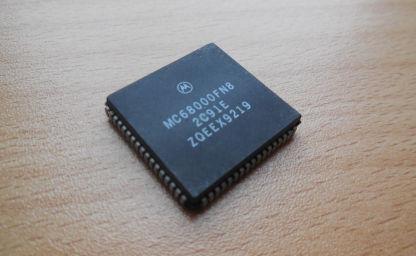Exploring the Amiga - Part 2
By Leonardo Giordani - Updated on
The library jump table¶
As already mentioned when a library is loaded in memory a jump table is created just before the library base address. This table contains the addresses of the functions exposed by the library, and Exec itself has one.
The jump table functions order for the Exec library is specified in one of the include files provided by the NDK, namely include_i/exec/exec_lib.i.
FUNCDEF Supervisor
FUNCDEF execPrivate1
FUNCDEF execPrivate2
FUNCDEF execPrivate3
...
FUNCDEF OpenLibrary
...
As you can see this file makes use of the FUNCDEF macro, which is not provided and has to be implemented by the coder. The idea of the macro is very simple: as the order of the jump table does not change we can just replace the first FUNCDEF with the offset of the first function in the library and then increment this offset with the default size of the jump address. The expected output of the macro is
_LVOSupervisor EQU -30
_LVOexecPrivate1 EQU -36
_LVOexecPrivate2 EQU -42
_LVOexecPrivate3 EQU -48
...
_LVOOpenLibrary EQU -552
...
Please note that the name of the function has been replaced by another string prepending _LVO to avoid clashes with the actual function definition (LVO stands for Library Vector Offset).
The above figures come from the "Special Constants" section contained in the include_i/exec/libraries.i file
*------ Special Constants ---------------------------------------
LIB_VECTSIZE EQU 6 ;Each library entry takes 6 bytes
LIB_RESERVED EQU 4 ;Exec reserves the first 4 vectors
LIB_BASE EQU -LIB_VECTSIZE
LIB_USERDEF EQU LIB_BASE-(LIB_RESERVED*LIB_VECTSIZE) ;First user func
LIB_NONSTD EQU LIB_USERDEF
AS you can see from the comments, Exec reserves the first 4 vectors, so the first function's address is LIB_USERDEF. To understand why the addresses are negative and how the offset is computed let's get a snapshot of the library once it has been loaded in memory
HIGHER MEMORY ADDRESSES
+-------------------------+
Last byte of the | End of the library |
library loaded in ---------> +-------------------------+
memory | [...] |
+-------------------------+
| Content of the library |
+-------------------------+
| Library structure |
Library base address ------> +-------------------------+
| 1st reserved vector |
+-------------------------+ <--- LIB_BASE
| 2nd reserved vector |
+-------------------------+ <--+
| 3rd reserved vector | | LIB_VECTSIZE
+-------------------------+ <--+
| 4th reserved vector |
+-------------------------+
| 1st defined function |
+-------------------------+ <--- LIB_USERDEF
| 2nd defined function |
+-------------------------+
| [...] |
+-------------------------+
First byte of the | End of the jump table |
library loaded in ---------> +-------------------------+
memory LOWER MEMORY ADDRESSES
You can find an official version of this in the documentation . Pay attention that the picture in the documentation represents memory upside down, with lower memory addresses towards the top of the page.
As you can see the library is loaded as expected from the base address towards the higher memory addresses, but at the same time the jump table is prefixed in reverse order. This is done to allow you to find the address of a function with a simple (negative) indexing instead of a more complex algorithm. Function number 1 is at address -1 * address_size, function number 2 at address -2 * address_size, etc.
This is why we use negative offsets to call library functions but positive ones to access the library data and structures.
You can also see from the figure where the Special Constants LIB_BASE and LIB_USERDEF are located. The actual values are
LIB_BASE EQU -6
LIB_USERDEF EQU -30
A good definition of the FUNCDEF macro, thus, is the following
INCLUDE "exec/libraries.i"
MACRO FUNCDEF
_LVO\1 EQU FUNC_CNT
FUNC_CNT SET FUNC_CNT-LIB_VECTSIZE
ENDM
FUNC_CNT SET LIB_USERDEF
The last line initialises the FUNC_CNT symbol with the LIB_USERDEF value. Then each call of the FUNCDEF <arg> macro does two things:
- Creates the
_LVO<arg>symbol with valueFUNC_CNT(e.g._LVOSupervisor EQU -30) - Decrements the
FUNC_CNTsymbol byLIB_VECTSIZE
Please note that the example FUNCDEF that you can find (commented) in libraries.i won't work out of the box as FUNC_CNT is defined inside the macro itself, while it has to be already defined before the first use of the macro.
*------ FUNCDEF is used to parse library offset tables. Many applications
*------ need a special version of FUNCDEF - you provide your own macro
*------ to match your needs. Here is an example:
*
* FUNCDEF MACRO
* _LVO\1 EQU FUNC_CNT
* FUNC_CNT SET FUNC_CNT-6 * Standard offset-6 bytes each
* FUNC_CNT EQU LIB_USERDEF * Skip 4 standard vectors
* ENDM
You can put the FUNCDEF macro code in a local include file like funcdef.i. Including it your code allows you to use _LVO prefixed labels for the functions that you want to load
INCLUDE "funcdef.i"
INCLUDE "exec/exec_lib.i"
move.l 4.w,a6
clr.l d0
move.l #libname,a1
jsr _LVOOpenLibrary(a6)
libname:
dc.b "somename.library",0
Finally, if you want to be even more explicit you can use the CALLLIB macro defined in libraries.i and write
INCLUDE "funcdef.i"
INCLUDE "exec/exec_lib.i"
INCLUDE "exec/libraries.i"
move.l 4.w,a6
clr.l d0
move.l #libname,a1
CALLLIB _LVOOpenLibrary
libname:
dc.b "somename.library",0
The four reserved vectors¶
As we saw, the Amiga system reserves 4 vectors at the beginning of the jump table of a library. These 4 spaces host 3 standard functions that shall be provided by any library, Open(), Close(), and Expunge(). The fourth slot is kept for possible future expansions and must contain a function that returns 0.
The offsets of these functions are contained in the include_i/exec/libraries.i file
*----------------------------------------------------------------
*
* Standard Library Functions
*
*----------------------------------------------------------------
LIBINIT LIB_BASE
LIBDEF LIB_OPEN
LIBDEF LIB_CLOSE
LIBDEF LIB_EXPUNGE ; must exist in all libraries
LIBDEF LIB_EXTFUNC ; for future expansion - must return zero.
the effect of the above macros with the previous constants is
LIB_OPEN EQU -6
LIB_CLOSE EQU -12
LIB_EXPUNGE EQU -18
LIB_EXTFUNC EQU -24
You can try to follow the definitions of the LIBINIT and LIBDEF macros to obtain the same result.
Types and structures¶
Let's see how the Exec library defines its types, which are the base components of the Amiga system. The main entry point for this investigation is the include_i/exec/types.i file.
When working with data structures in Assembly, everything is expressed in terms of offsets. The main idea behind structures is to create something like this
STRUCT1 EQU 0
OFFS SET 0
FIELD1 EQU OFFS
OFFS EQU OFFS+SIZE_OF_FIELD1
FIELD2 EQU OFFS
OFFS EQU OFFS+SIZE_OF_FIELD2
; ...
STRUCT1_SIZE EQU OFFS
which, once run through the macro expansion, creates the following code
STRUCT1 EQU 0
FIELD1 EQU 0
FIELD2 EQU SIZE_OF_FIELD1
FIIELD3 EQU SIZE_OF_FIELD1+SIZE_OF_FIELD2
; ...
STRUCT1_SIZE EQU SIZE_OF_FIELD1+...+SIZE_OF_FIELDn
So, the type macros are all defined with code like this
TYPENAME MACRO
\1 EQU SOFFSET
SOFFSET SET SOFFSET+SIZE_OF_TYPE
ENDM
For example the BYTE macro is
BYTE MACRO ; byte (8 bits)
\1 EQU SOFFSET
SOFFSET SET SOFFSET+1
ENDM
Note that the field is defined with EQU to avoid unwanted overwrites, while SOFFSET uses SET that allows to redefine the symbol.
Let's see now how a real structure is defined. A good example is LN defined in include_i/exec/nodes.i which represents a node of a linked list.
STRUCTURE LN,0 ; List Node
APTR LN_SUCC ; Pointer to next (successor)
APTR LN_PRED ; Pointer to previous (predecessor)
UBYTE LN_TYPE
BYTE LN_PRI ; Priority, for sorting
APTR LN_NAME ; ID string, null terminated
LABEL LN_SIZE ; Note: word aligned
The STRUCTURE macro is defined in types.i as
STRUCTURE MACRO ; structure name, initial offset
\1 EQU 0
SOFFSET SET \2
ENDM
And the resulting declarations, once the macros have been expanded, are the following
LN EQU 0
LN_SUCC EQU 0
LN_PRED EQU 4
LN_TYPE EQU 8
LN_PRI EQU 9
LN_NAME EQU 10
LN_SIZE EQU 14
As you can see the field names are just offsets inside the structure, and there is no specific padding at the end to align the structure. In this case there is no need, as the structure size is already a multiple of a word (14 bytes).
How to align structures
If we need to align the bytes however we can use a little binary trick. If you ignore the least significant bit of a binary number you convert it to the nearest even number (downwards). An example in Python is
>>> bin(13)
>>> '0b1101'
>>> bin(12)
>>> '0b1100'
You can ignore the least significant bits with a simple bitwise AND
>>> bin(14)
'0b1110'
>>> 14&0b1100
12
So, given the current offset, if we increase it by one and round down to the nearest integer we are aligning the offset to multiples of a word (2 bytes). The ALIGNWORD macro in the include_i/exec/types.i file implements exactly this algorithm
ALIGNWORD MACRO ; Align structure offset to nearest word
SOFFSET SET (SOFFSET+1)&$fffffffe
ENDM
This can be seen in action in the CardHandle structure defined in include_i/resources/card.i. The same algorithm is implemented in other parts of the Kickstart code, for example in the AddMemList function that adds memory space to the free memory pool.
Markus Wandel's work¶
After three years since I began this investigation I came across the work of Marcus Wandel (http://wandel.ca), advertised on Amiga Transactor September 1989. Mr Wandel disassembled the whole Kickstart 1.2 ROM back in 1989, and you can find the result of his effort on his website at http://wandel.ca/homepage/execdis/index.html. I'm currently using his comments to check what I find out on my own, because I don't want to spoil the joy of discovery, and so far they confirmed I'm on the right path.
I think what Mr Wandel did is a great example of what computer science truly is. I'm sure his impressive contribution helped people to understand the Amiga system back in the ages, and it's definitely helping me 32 years later. Without the effort and the passion of people like Marcus Wandel, computer science would be just another corporate-owned environment.
Marcus's name is not as famous as that of other big players, but I consider his work extremely important. Thanks Marcus for your work and thanks to all the people who contributed to the Amiga, and to the rise of microcomputers.
What's next¶
The next article will describe in depth how the jump table of the Exec library is created through the MakeFunctions routine. This will be shown step by step discussing the reverse engineering method followed to discover the mechanism and the relevant code.
Resources¶
- Amiga System Programmers Guide, Abacus
- AmigaOS Developer Docs
- Marcus Wandel's disassmbly of Kickstart 1.2
Feedback¶
Feel free to reach me on Twitter if you have questions. The GitHub issues page is the best place to submit corrections.
Part 2 of the Exploring the Amiga series
Related Posts
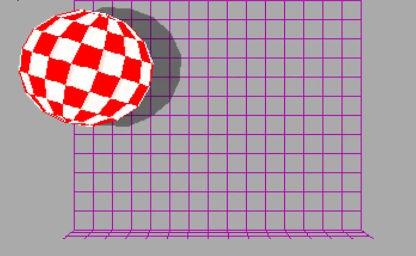
Exploring the Amiga - Part 8
Updated on
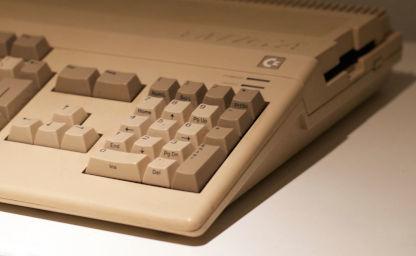
Exploring the Amiga - Part 7
Updated on

Exploring the Amiga - Part 6
Updated on

Exploring the Amiga - Part 5
Updated on
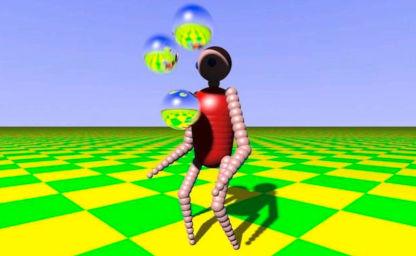
Exploring the Amiga - Part 4
Updated on
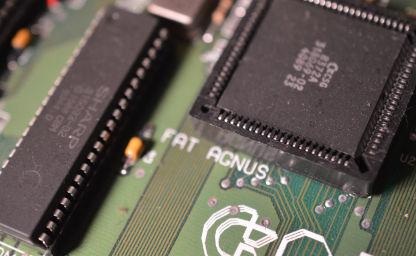
Exploring the Amiga - Part 3
Updated on
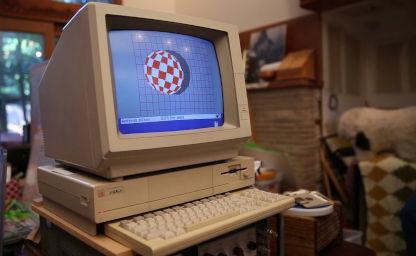
Exploring the Amiga - Part 1
Updated on
